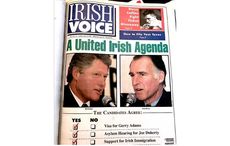It is one of the more curious eras in Irish and American history: from September of 1939, when Hitler and Germany invaded Poland igniting World War II, up to December 1941, when the Japanese bombed Pearl Harbor and America officially entered the bloody war.
This era is curious because the Irish in America are so often remembered as patriotic, particularly when it comes to military service. Going as far back as the Revolutionary War, George Washington honored the Irish for defending their adopted country. Millions of Famine immigrants, meanwhile, fought for the Union in the Civil War.
What’s often forgotten -- intentionally or not -- is that Irish immigrants occasionally (and uncomfortably) aligned themselves with America’s enemies as well. Look no further than the San Patricio brigade which fought for Mexico against the U.S. in the 1840s.
Things, of course, were much more complex in the late 1930s and early 1940s. The international politics of this fascinating era will be the focus of a lecture and discussion on Thursday, November 12 at 7 p.m. at St. John’s University’s Manhattan campus. (Yours truly will be among the panelists.)
The lecture is being held to mark the 75th anniversary of the founding of a group called the American Friends of Irish Neutrality (AFIN). AFIN was a prominent group founded by, among others, longtime New York City politician and activist Paul O’Dwyer, a Mayo native who went on to serve as New York City Council president.
Other AFIN members included Sean Keating, a veteran of the Irish War of Independence who became a deputy mayor under New York Mayor Bobby Wagner, and Fordham Professor James O’Brien.
AFIN argued that America should stay out of the raging war Hitler had kicked off in Europe. It was part of a much broader, oft-forgotten movement of neutrality which swiftly vanished in the wake of Pearl Harbor.
The Irish, of course, had distinctive reasons to advocate for neutrality. Among them? In fighting against Germany, the U.S. would aid Ireland’s longtime rival Great Britain.
As part of the lecture on November 12, St. John’s archives will display records and other AFIN documents.
“The special collection housed at St. John’s captures a moment in time when Irish foreign policy was literally being formed and felt on the streets of New York City,” said Brian Browne, assistant vice president for government relations at St. John’s, who is coordinating the lecture.
“The grassroots organization skills of the Irish American community at the time are a great lesson plan that endures for political advocacy today.”
On the 12th, Browne will lead a panel discussion featuring attorney (and son of Paul) Brian O’Dwyer, as well as Matthew Larkin (grandson of Sean Keating) and Irish Echo editor Ray O’Hanlon.
The collection of AFIN documents and other materials at St. John’s contains correspondence between AFIN members as well as telegrams sent to President Franklin Roosevelt, Irish Taoiseach Eamon de Valera as well U.K. Prime Minister Winston Churchill. The collection, a treasure trove for historians of the era, also contains photographs, cartoons, speeches, newspaper clippings and AFIN membership records.
The AFIN and the broader neutrality movement was, of course, controversial. Once-prominent U.S. heroes such as Charles Lindbergh were castigated for what many viewed as their sympathy for Nazi Germany. Some accused Irish Americans of putting their loyalty to Ireland ahead of their adopted homeland.
AFIN disbanded right after Pearl Harbor and millions of Irish Americans fought nobly for their country, though Irish neutrality during the war remained a sore subject, never more so than when Eamon de Valera paid diplomatic respects to German leader Adolf Hitler following the dictator’s death.
What is important to remember in all of this is that immigrants have always struggled to balance their love of the old world and the new.
The St. John’s Manhattan Campus is located at 101 Astor Place between 3rd and 4th Avenues. To attend the AFIN lecture or for more information call 718-990-2762.




Comments